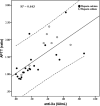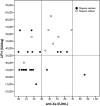Heparin dosage, level, and resistance in SARS-CoV2 infected patients in intensive care unit
- PMID: 33855802
- PMCID: PMC8251410
- DOI: 10.1111/ijlh.13543
Heparin dosage, level, and resistance in SARS-CoV2 infected patients in intensive care unit
Abstract
Introduction: Patients with COVID-19 frequently exhibit a hypercoagulable state with high thrombotic risk, particularly those admitted to intensive care units (ICU). Thromboprophylaxis is mandatory in these patients; nevertheless, thrombosis still occurs in many cases. Thus, the problem of assessing an adequate level of anticoagulation in ICU patients becomes evident during the COVID-19 pandemic. The aim of this study was to evaluate the heparin resistance and the efficacy of heparin monitoring using an anti-Xa activity assay.
Methods: Thirty-seven heparin-treated patients admitted to ICU for SARS-CoV-2 pneumonia were retrospectively studied for antifactor Xa activity (anti-Xa), activated partial thromboplastin time (APTT), Antithrombin, Fibrinogen, D-Dimer, Factor VIII, von Willebrand Factor, and the total daily amount of heparin administered. The correlation between APTT and anti-Xa was evaluated for unfractionated heparins (UFH). The correlations between the daily dose of UFH or the dosage expressed as IU/kg b.w. for low molecular weight heparin (LMWH) and anti-Xa were also evaluated.
Results: Twenty-one patients received calcium heparin, 8 sodium heparin, and 8 LMWH. A moderate correlation was found between APTT and anti-Xa for UFH. APTT did not correlate with coagulation parameters. 62% of UFH and 75% of LMWH treated patients were under the therapeutic range. About 75% of patients could be considered resistant to heparin.
Conclusions: SARS-COV2 pneumonia patients in ICU have frequently heparin resistance. Anti-Xa seems a more reliable method to monitor heparin treatment than APTT in acute patients, also because the assay is insensitive to the increased levels of fibrinogen, FVIII, and LAC that are common during the COVID-19 inflammatory state.
Keywords: COVID-19; activated partial thromboplastin time; anti-Xa; anticoagulant monitoring; critical care; heparin resistance.
© 2021 John Wiley & Sons Ltd.
Conflict of interest statement
Dr Chiara Novelli has received lecture fees and consultancy fees from Instrumentation Laboratory‐Werfen, outside the scope of the submitted work. The other authors have no competing interests.
Figures


Comment in
-
Resistance or pitfall in heparin monitoring: An ongoing issue in COVID-19 anticoagulation.Int J Lab Hematol. 2022 Aug;44(4):e135-e137. doi: 10.1111/ijlh.13778. Epub 2021 Dec 16. Int J Lab Hematol. 2022. PMID: 34914184 No abstract available.
Similar articles
-
The PiCT® test is a reliable alternative to the activated partial thromboplastin time in unfractionated heparin therapy management: results from a multicenter study.J Thromb Haemost. 2016 Nov;14(11):2187-2193. doi: 10.1111/jth.13489. Epub 2016 Oct 19. J Thromb Haemost. 2016. PMID: 27582411
-
Activated partial thromboplastin time versus antifactor Xa heparin assay in monitoring unfractionated heparin by continuous intravenous infusion.Ann Pharmacother. 2011 Jul;45(7-8):861-8. doi: 10.1345/aph.1Q161. Epub 2011 Jun 28. Ann Pharmacother. 2011. PMID: 21712506
-
Anticoagulation Monitoring with Activated Partial ThromboPlastin Time and Anti-Xa Activity in Intensive Care Unit Patients: Interest of Thrombin Generation Assay.Int J Mol Sci. 2022 Sep 23;23(19):11219. doi: 10.3390/ijms231911219. Int J Mol Sci. 2022. PMID: 36232517 Free PMC article.
-
Antifactor Xa levels versus activated partial thromboplastin time for monitoring unfractionated heparin.Pharmacotherapy. 2012 Jun;32(6):546-58. doi: 10.1002/j.1875-9114.2011.01049.x. Epub 2012 Apr 24. Pharmacotherapy. 2012. PMID: 22531940 Review.
-
Anticoagulation for COVID-19 Patients: A Bird's-Eye View.Clin Appl Thromb Hemost. 2021 Jan-Dec;27:10760296211039288. doi: 10.1177/10760296211039288. Clin Appl Thromb Hemost. 2021. PMID: 34595937 Free PMC article. Review.
Cited by
-
Development of a Decision Support Tool for Anticoagulation in Critically Ill Patients Admitted for SARS-CoV-2 Infection: The CALT Protocol.Biomedicines. 2023 May 23;11(6):1504. doi: 10.3390/biomedicines11061504. Biomedicines. 2023. PMID: 37371599 Free PMC article.
-
Efficacy and Safety of Direct Oral Anticoagulants Compared With Heparin for Preventing Thromboembolism in Hospitalized Patients With COVID-19: A Systematic Review and Meta-Analysis.Clin Appl Thromb Hemost. 2023 Jan-Dec;29:10760296231164355. doi: 10.1177/10760296231164355. Clin Appl Thromb Hemost. 2023. PMID: 37131319 Free PMC article.
-
Serial thrombin generation and exploration of alternative anticoagulants in critically ill COVID-19 patients: Observations from Maastricht Intensive Care COVID Cohort.Front Cardiovasc Med. 2022 Oct 6;9:929284. doi: 10.3389/fcvm.2022.929284. eCollection 2022. Front Cardiovasc Med. 2022. PMID: 36277784 Free PMC article.
-
A Case of COVID-19 Related Coagulopathy Complications and Heparin Resistance.Cureus. 2021 Sep 25;13(9):e18265. doi: 10.7759/cureus.18265. eCollection 2021 Sep. Cureus. 2021. PMID: 34722046 Free PMC article.
-
Resistance to unfractionated heparin in the ICU: evaluation and management options.Intensive Care Med. 2023 Aug;49(8):1005-1007. doi: 10.1007/s00134-023-07103-x. Epub 2023 Jun 6. Intensive Care Med. 2023. PMID: 37278759 Free PMC article. No abstract available.
References
MeSH terms
Substances
LinkOut - more resources
Full Text Sources
Other Literature Sources
Medical
Miscellaneous

